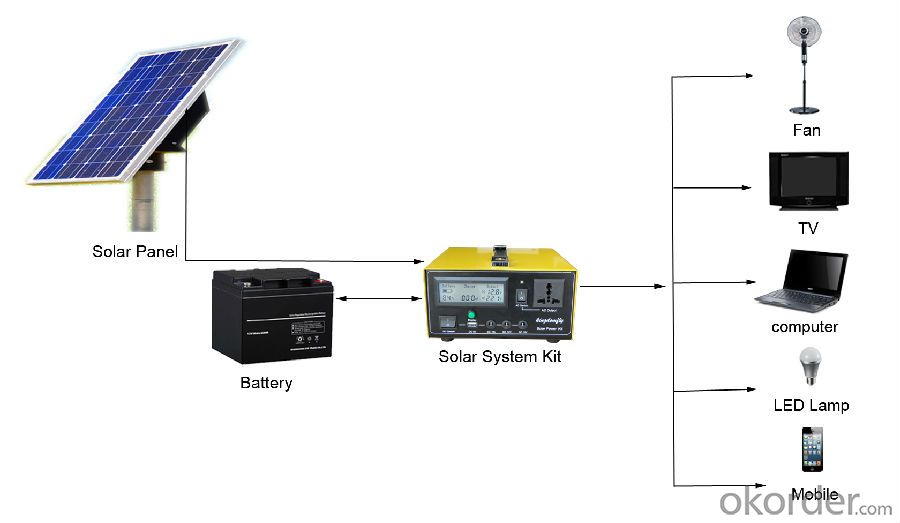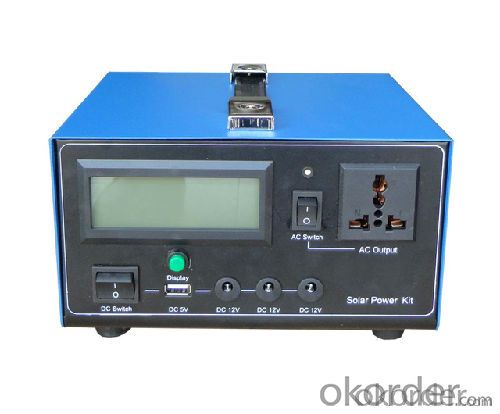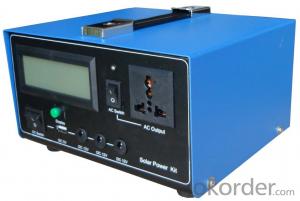Solar Power System Hot Selling SPK_300_LCD
- Loading Port:
- China main port
- Payment Terms:
- TT or LC
- Min Order Qty:
- 10 pc
- Supply Capability:
- 10000 pc/month
OKorder Service Pledge
OKorder Financial Service
You Might Also Like
A solar inverter, or PV inverter, or Solar converter, converts the variable direct current (DC) output of a photovoltaic (PV) solar panel into a utility frequency alternating current (AC) that can be fed into a commercial electrical grid or used by a local, off-grid electrical network.
It is a critical BOS–component in a photovoltaic system, allowing the use of ordinary AC-powered equipment.
Solar inverters have special functions adapted for use with photovoltaic arrays, including maximum power point tracking and anti-islanding protection.
Main Information
KDF SPK_300_LCD
This product is high performance, family used portable solar power system, which can receive energy and store it in battery outside connected to SPK by solar energy on sunny day, and supplies electric power for varies appliances such as electric fan, lighting lamps, television, portable computer etc.
It can supply power for both DC and AC electric application.

Main features:
◆ Battery puts outside connected to the SPK for user to choose battery in recommended range, and easily to exchange battery.
◆ Both DC and AC output
◆ Solar Feedback Circuit Protection
◆ Output Short-circuit Protection
◆ Solar「+」「-」anti-access protection
◆ Output「+」「-」anti-access protection
◆ Over Charged Protection
◆ Over Discharged Protection
◆ Over Load Protection
◆ Over-Temperature Protection
Technical parameters
Specification | Value/Material | |
Item No. KDF | SPK_300_LCD | |
Solar Recommended | Specification | Poly silicon |
Working Voltage/Power | 18V80W~120W | |
Battery Recommended | Rated Voltage/Capacity | 12V65AH~100AH |
Cycle Number | 80% Deep Cycle Number:500 70% Cycle Number:800 | |
Working Temperature | Short Period(one Month):-20~50℃ Long Period(Six Months):-10~45℃ | |
Charging Controller | Operating Voltage | 12V |
Input Voltage | 17.3V~21V | |
Input current | MAX:10A | |
Power Consumption | MAX: 5mA | |
Low Voltage Disconnect(LVD) | 10.8V | |
Low Voltage Reconnect(LVR) | 12.3V | |
High Voltage Discharge( HVC) | 14.6V | |
High Voltage Recharge(HVR) | 13.8V | |
Temperature Protection | 60℃ | |
DC Output | DC output & Application | USB 5V2A |
DC output & Application | DC 12V1*3A | |
AC Output | Output Wave | modified sine wave |
Input Voltage | 11V~15V | |
Output Voltage | 110V±10% | |
Output Frequency | 60Hz±2Hz/50Hz±2Hz | |
Rated Output Power | 300W | |
Maximum VA | 600VA | |
Maximum Efficiency | 88% | |
Temperature | 0-40℃ | |
Over Temperature | 60℃~70℃ | |
Low Voltage Alarm | 11V | |
Low Voltage Shut off | 10.5V | |
High Voltage Shut off | 16V | |
Package | Set size | 278*240*172mm |
Set N·W | 2.8kg | |
Set N·W | 3.6kg | |


No. | Name | Function |
1 | Battery Icon | To show the Volume of the Battery |
2 | Date of % | To show the percent of the Battery |
3 | Charging Icon | To show the charging condition |
4 | Current | To show the value of charge current |
5 | Temperature Icon | Temperature Alarm |
6 | Date of Voltage | To Show the Value of DC output voltage |
7 | Date of Voltage | To Show the Value of AC output voltage |
8 | AC Icon | AC output |
9 | DC Icon | DC output |
This product can be used for any type of solar home systems. It has high conversion efficiency, reliable quality, intelligent monitoring system and best service, which will provide you with a memorable user experience and solutions.
- Q:Can a solar energy system be installed on a church or religious building?
- A church or religious building can indeed have a solar energy system installed. Actually, numerous religious organizations have begun to adopt solar energy as an eco-friendly and sustainable approach to diminishing their carbon footprint and cutting down energy expenses. The installation of solar panels on the roof of such establishments enables the production of clean and renewable energy, thereby powering the facility and lessening its dependence on conventional energy sources. Furthermore, by embracing solar power, religious organizations can serve as role models within their communities, inspiring others to embrace clean energy practices.
- Q:Are there any insurance requirements for installing a solar energy system?
- Yes, there are insurance requirements for installing a solar energy system. While the specific requirements may vary depending on the location and individual circumstances, it is generally recommended to have appropriate insurance coverage in place when installing a solar energy system. This is important as it helps protect your investment and provides financial security in case of any unexpected damages or accidents. One of the most common insurance requirements for solar energy systems is property insurance. This covers any damage or loss to the physical components of the system, such as solar panels, inverters, and batteries. Property insurance typically protects against risks like fire, theft, vandalism, and natural disasters. Additionally, liability insurance is often necessary when installing a solar energy system. This coverage helps protect you from potential legal claims arising from accidents or injuries that may occur during the installation or operation of the system. Liability insurance may also provide coverage for any damage caused to neighboring properties. In some cases, if you are financing your solar energy system through a loan or lease, the lender or leasing company may require specific insurance coverage as a condition of the agreement. These requirements may include certain coverage limits, additional insured endorsements, or even specific insurance providers. It is important to consult with your insurance provider and solar installer to ensure that you have the appropriate insurance coverage in place before installing a solar energy system. They will be able to guide you through any specific requirements or recommendations based on your location and individual circumstances.
- Q:How do solar energy systems impact greenhouse gas emissions?
- Solar energy systems have a significant positive impact on greenhouse gas emissions as they generate electricity without producing any greenhouse gases during operation. By replacing traditional fossil fuel-based power sources, solar energy reduces the overall amount of greenhouse gases released into the atmosphere, thus helping mitigate climate change.
- Q:How much do solar energy systems cost?
- The cost of solar energy systems varies depending on several factors such as the size of the system, the location, and the specific components used. On average, a residential solar system can range from $15,000 to $25,000 after accounting for federal tax incentives and other rebates. However, it's important to note that prices have been declining rapidly in recent years, making solar energy more affordable and cost-effective in the long run.
- Q:Can solar energy systems be installed on mobile homes?
- Yes, solar energy systems can be installed on mobile homes.
- Q:How do solar energy systems impact the electricity generation mix?
- Solar energy systems have a significant impact on the electricity generation mix by diversifying it and reducing reliance on fossil fuels. The integration of solar power into the mix increases the share of renewable energy sources, which helps reduce greenhouse gas emissions and combat climate change. Additionally, solar energy systems contribute to decentralization and grid resilience, as they can be installed at various scales, promoting a more sustainable and efficient electricity generation landscape.
- Q:How does a solar panel convert sunlight into electricity?
- A solar panel converts sunlight into electricity through the photovoltaic effect. When sunlight hits the solar panel, it excites the electrons in the semiconductor material, creating a flow of electric current. This current is then collected and used as electricity.
- Q:What are the key components of a solar energy system?
- The key components of a solar energy system include solar panels, an inverter, a mounting system, batteries (optional), and a monitoring system.
- Q:Can solar energy systems be combined with other renewable energy sources?
- Yes, solar energy systems can be combined with other renewable energy sources. This approach is known as hybrid renewable energy systems. By combining multiple sources such as solar, wind, hydro, or geothermal, we can maximize energy production and ensure a more reliable and consistent power supply. This integration allows for better utilization of resources, increased energy efficiency, and helps to mitigate the intermittent nature of certain renewable sources.
- Q:Can solar energy systems be used in areas with limited access to food?
- Yes, solar energy systems can be used in areas with limited access to food. Solar energy systems provide a sustainable and reliable source of electricity, which can power various applications, including food production and processing. Solar-powered irrigation systems can be used to water crops, while solar-powered refrigeration can help preserve food. Additionally, solar energy can be utilized to power hydroponic or vertical farming systems, enabling food production in limited spaces. Therefore, solar energy systems can play a crucial role in addressing food scarcity and promoting food security in areas with limited access to food.
1. Manufacturer Overview |
|
|---|---|
| Location | |
| Year Established | |
| Annual Output Value | |
| Main Markets | |
| Company Certifications | |
2. Manufacturer Certificates |
|
|---|---|
| a) Certification Name | |
| Range | |
| Reference | |
| Validity Period | |
3. Manufacturer Capability |
|
|---|---|
| a)Trade Capacity | |
| Nearest Port | |
| Export Percentage | |
| No.of Employees in Trade Department | |
| Language Spoken: | |
| b)Factory Information | |
| Factory Size: | |
| No. of Production Lines | |
| Contract Manufacturing | |
| Product Price Range | |
Send your message to us
Solar Power System Hot Selling SPK_300_LCD
- Loading Port:
- China main port
- Payment Terms:
- TT or LC
- Min Order Qty:
- 10 pc
- Supply Capability:
- 10000 pc/month
OKorder Service Pledge
OKorder Financial Service
Similar products
New products
Hot products
Related keywords































